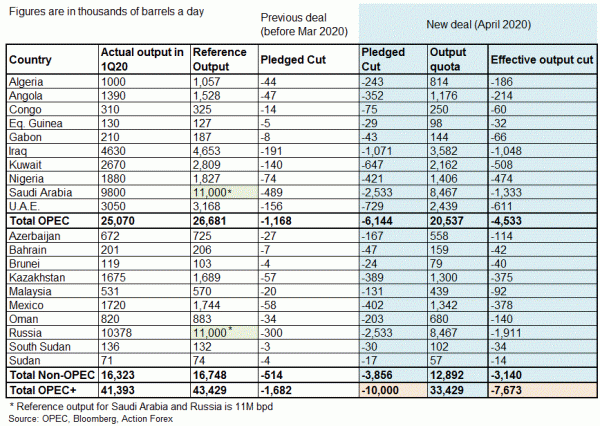OPEC+ eventually agreed on a final deal to reduce oil production by -10M bpd. Despite the significant headline figure, the effective cut is much lower. Actual output cut, late start and compliance issues suggest that the deal should not offer much help to the demand/supply balance in the oil market. As such, we expect risk to oil price is skewed to the downside in the coming months.
The final deal is as follows: OPEC+ will reduce oil production by an aggregate 10M bpd in May and June. The cut will fall to 8M bpd from July until end-2020, followed by a decline to 6M bpd from January 2020 to April 2022. Participating countries will meet on June 10 2020 to discuss further adjustment. The cut will use production in October 2018 as the baseline, while Saudi Arabia and Russia will use 11M bpd as the reference. Same as previous OPEC+ deal, Iran, Libya and Venezuela will be exempted. Mexico last week walked out from the deal as it only accepted to lower output by 100K bpd, compared with the required 400K bpd. The issue was resolved as the US agreed to shoulder the remaining 300K bpd.
Despite the large headline reading (output cut of 10M bpd), it does not seem to be able to solve the oversupply situation. As noted by the International Energy Agency, “we may well see sometime throughout this year demand to fall down, as some say, about 20M bpd”. Moreover, the output quota is referenced from October 2018’s production level. The effective cut was only modestly over 7M bpd if 1Q20’s production is used as the baseline. Meanwhile, the coordinated cut will start in May, a two months’ lag from the severe decline in global oil demand triggered by the coronavirus pandemic. Compliance has been a problem, evidenced from previous OPEC+ deals. Saudi Arabia usually shoulders most of the reduction, while Iraq and Nigeria cut less than promised. In January 2020, Iraq and Nigeria only lowered 80% and 69% of the promised output cut. Yet, total OPEC compliance was 138%. Non-OPEC producers were notoriously for producing more than promised. Overall non-OPEC compliance rate was only 76% in January 2020.
Less-than-expected effective output cut, late start of the reduction and compliance problems suggest that the coordinated cut would offer little help to re-balance supply/demand in the oil market.













